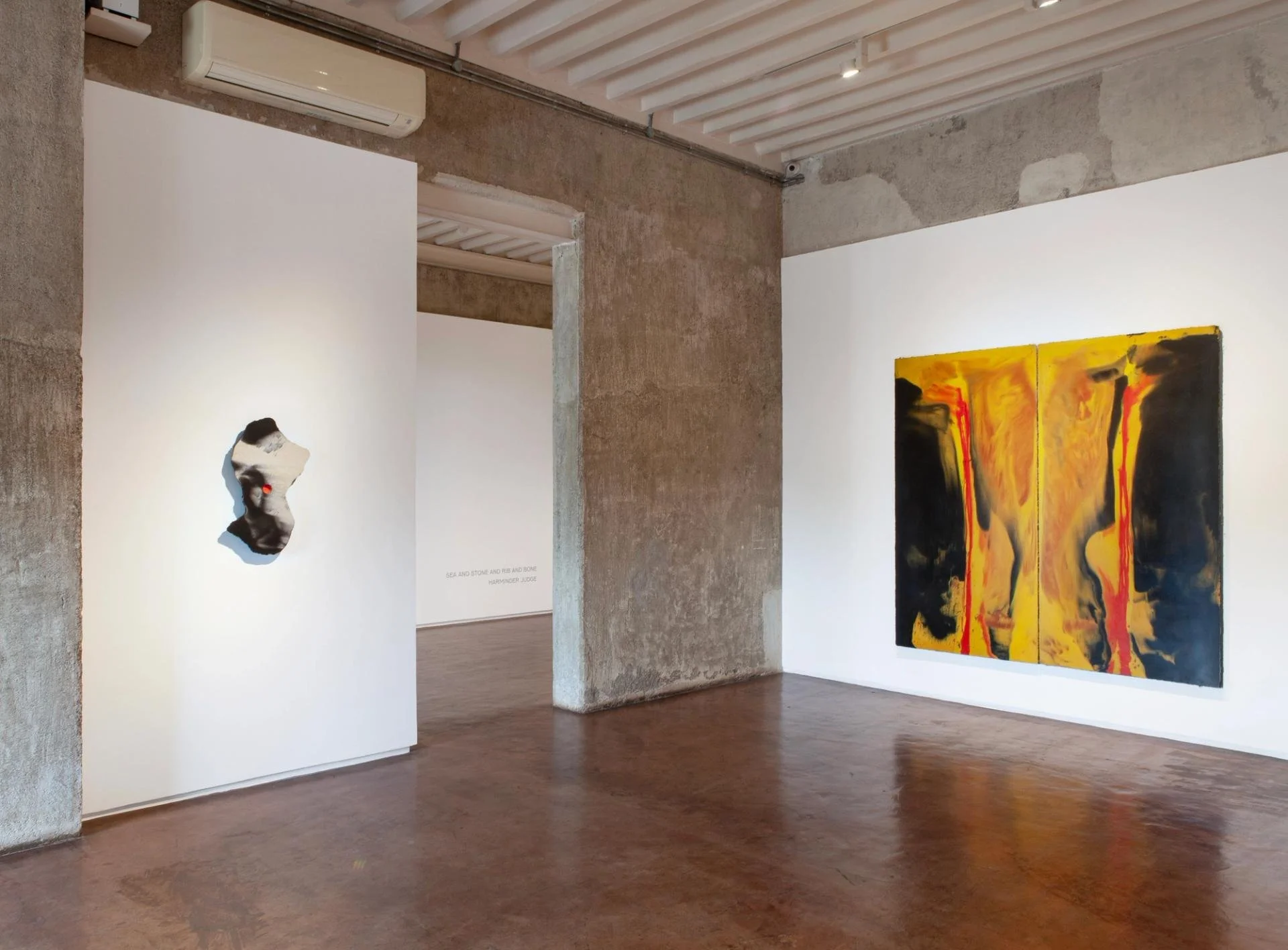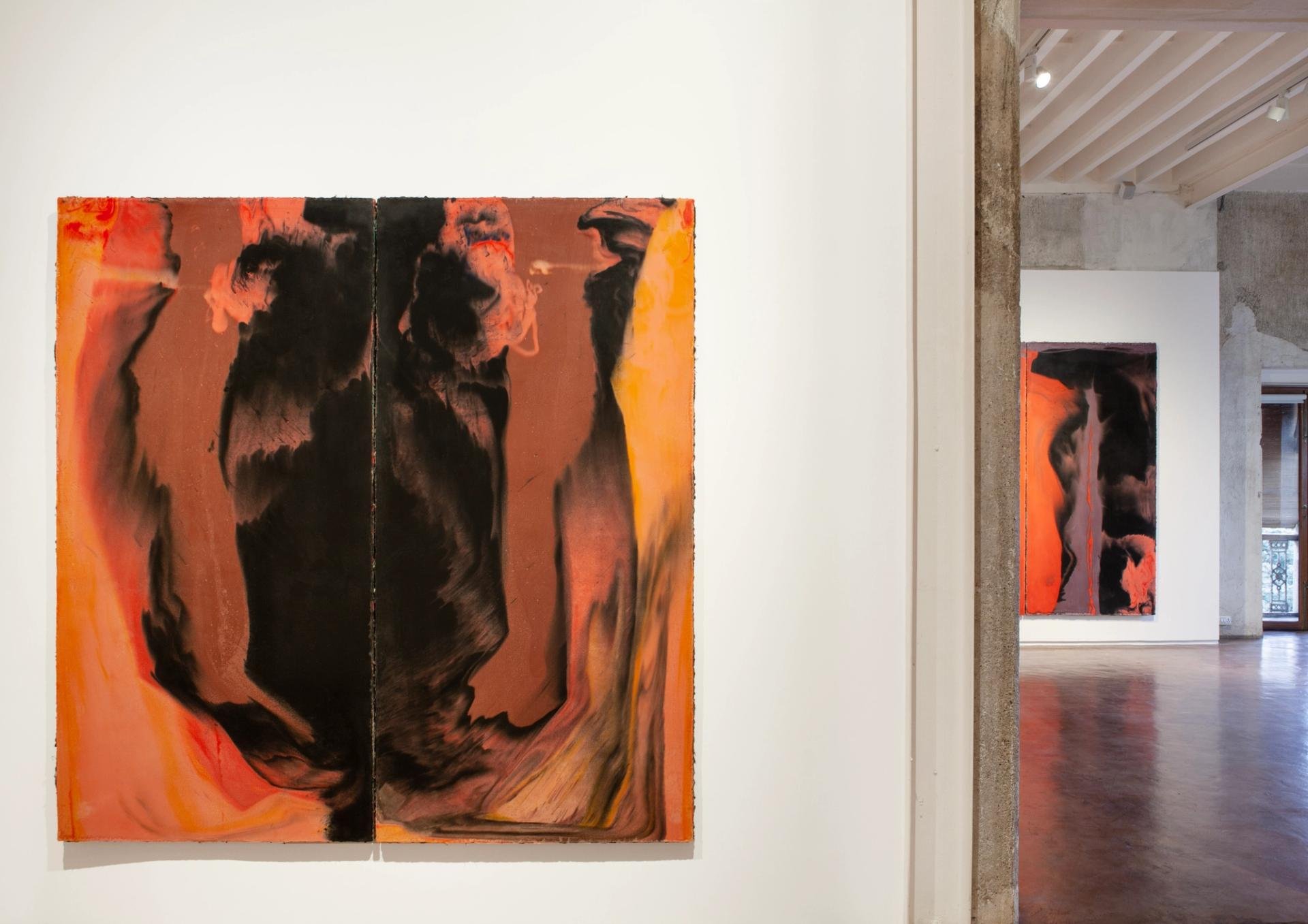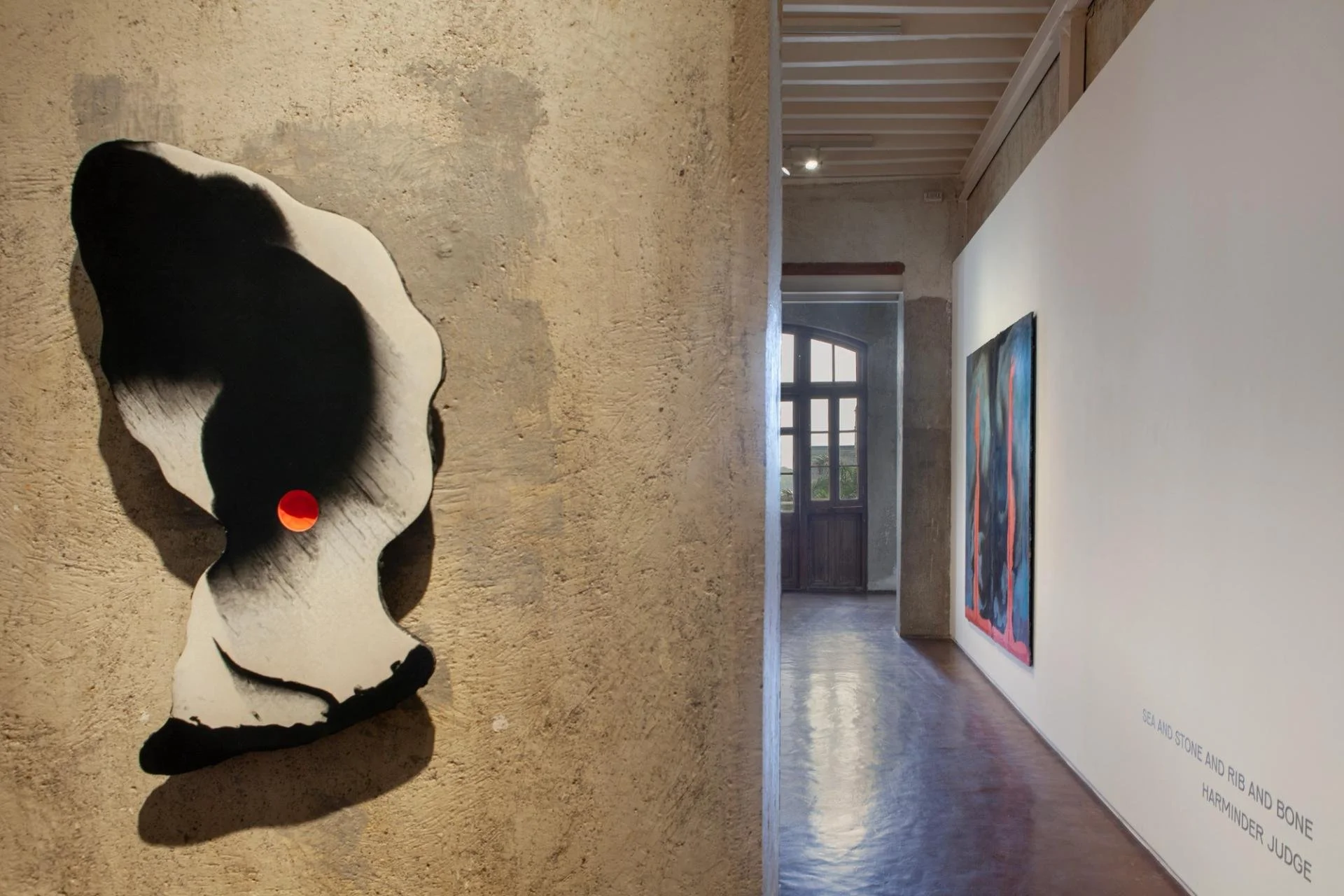HARMINDER JUDGE:
SEA AND STONE AND RIB AND BONE
Jhaveri Contemporary, India
Exhibition Text by Susanna Davies-Crook
HARMINDER JUDGE
SEA AND STONE AND RIB AND BONE
9 NOV–23 DEC 2023
Spectres and Portals: The Work of Harminder Judge
In Untitled (shoot through soil), 2023, a fleshy cosmic tear appears in the surface of two large, rectangular tablets. Foreground and background—spectre and portal—seduce us into the beyond. The panels are an almost-mirror, compositionally reminiscent of neo-tantric and visionary art as well as minimalism and conceptualism. The flattest image gives way to depth at arm’s length: whirls of smokeless fire and fireless smoke embed themselves in the smooth surface. These objects are lives between lives. They are the doors of perception and consciousness and mark passage into liminal realms through the meeting of form and chaos, of intention and outcome, of God and man. Apparitions approach and recede like the tide polishing a stone. The elements are all here: earth in the gypsum, air in the words spoken, water mixed with pigment, fire and heat on surface.
Through the shapes and forms blooming from the picture plane, the artist seeks to embed a constellation of meaning within us. What he conjures is up to you, the viewer: a fire-breathing God, a smoking volcano, a demon, a mother, or mere human form. The weaving of meaning is as much Harminder Judge’s medium as plaster and scrim. As with cloud gazing, Rorschach, tasseography or scrying, it is not only the medium, but the intention to truly see that binds these acts of divination. Whether neurological pattern recognition on the part of the observer, or direct messages from spirit, the human body acts as the transistor for interpretation. As poet Nisha Ramayya describes, Tantra itself is a weaving. 'Tantra, n. A loom; the warp; the leading or principal or essential part, system, framework; doctrine, rule, theory, chapter of such a work; a class of works teaching magical and mystical formularies… Tantra is the practice of extending, of stretching to make connections, of creating something from those connections. Tantra is the weaving of multiple threads and the extrication of one part from the whole.'1 To stand among these works as a lifeform between portals creates a kind of cosmology within the room. The works speak not only to us, but with each other. When the gallery is closed and the human observers have left, perhaps the objects observe their partners as relatives in this galaxy of meaning.
Here lies the inextricable link between spirituality and form: the cosmic spiral of a snail’s whorl and the breaking down of image into geometry, grid and the line at the heart of things. These are the building blocks of life, the forms of nature and cosmic order. With nods to William Blake’s heavens and hells and Robert Smithson’s Spiral Jetty,1970, the history of spirituality, psychedelic exploration and modernism is inextricable. In recent years the rise in psychedelic medicine and DMT journeys speaks to the still-constant desire to know the ineffable and touch the unknown. New thinking on science and morphic resonance by Rupert Sheldrake weaves paths through Huxley’s legacy and Jung’s collective consciousness.2
Through his self-developed process of layering both meaning and matter, of creation and destruction, Judge channels the wonder of the universal through the everyday. His materials—plaster, pigment, oil and hessian—are found in commonplace building materials, and also in the history of art and belief. Pigment can be found in Renaissance egg tempera painting and masonry paint, as well as in sacred ceremony. Plaster is as easily employed to secure a makeshift wall in a dwelling as it is an elevated Italian fresco. This collapsing of influence and process solidifies the daily ritual of arriving to the studio and entering the material flow.
Certain bodies pass through the fabric of space-matter-time, like love. Ritual, as grief, is a mark of this need to make manifest what is felt. The works in this exhibition feel like they hold love—for repetition, texture, time and chance. They have been created over weeks, through temporal dedication and devotional practice, with Judge repeatedly layering powdered pigments and wet plaster through bonds of hessian scrim. They are the product of an almost geological stratification; to take a cross-section is to see time. The artist’s acts are repetitive, like Mantra. The sacred act of looping, in ritual form, making solid what was once a breath; the whisper of an idea. There is also an element of chance—or maybe destiny— at play, as the artist makes the works face-down, blind to the end result. The plaster layers are poured into large tray beds, the pigment added with no guarantee as to what the final reveal will uncover when the piece is finally lifted and its visage revealed.
Judge’s process itself is alchemy, with incidental consequence. The artist’s hand exchanges heat and intention for mark and legacy. As Carlo Rovelli describes in The Order of Time, 'heat cannot pass from a cold body into a hot one. The crucial difference here is what happens with falling bodies: a ball may fall, but it can come back up by rebounding, for instance. Heat cannot. This is the only basic law of physics that distinguishes the past from the future. In the elementary equations of the world, the arrow of time appears only where there is heat.' As Judge describes the plastering process: 'When I make that first layer, it’s thin in parts and then in others it’s quite thick. When plaster sets, it gives us what’s called an exothermic reaction: it heats up as it dries. That’s why, if you put your hand on drying plaster, it’s really warm. It’s nice in the winter when you’re working.' The pigments move between form and state, from solid to dust to liquid to solid again. Once the works are ready, when the thickness of these layers is complete, they are lifted off their flat beds and made into object. Like precious stones or obsidian mirrors in a process with a nod to Indian glass painting, the surface is polished and oiled, like skin. Then hung, floating from the wall, hovering like magician’s cloth.
If, as observer, we slide into a sideways state; allow the eyes to rest in their sockets; drop in and watch the mind become simultaneously loose and sharp then gaze into the colour—shapes and feelings bud into life. They talk the language of modern art, especially of colour field paintings, and of aura, chakras and somatics. As the artist described in our studio visit, 'I think about composition and order and I’m thinking a lot more about colour… I only really use the primary colours—yellow, blue, red—then it kind of mixes itself as I move it around… these works are stepping a little bit into figuration. There’s a background, there’s a foreground, there’s an object.' Other visionary greats like Hildegard of Bingen, Piet Mondrian, Hilma af Klint and Ithell Colquhoun3 inhabit and explore intuitive colour as mediumship. For Judge, visionary inquiry is honed through process and the sublime cohabits with formalism. Hildegard of Bingen’s cosmic mandalas are a bridge to divine order. In Mondrian’s trees and distilled grid spectrums, form and colour manifest in linearity. In af Klint’s channelled pinks and pastels a language of organic form and balance arrives, and in her monochrome Series II works lands the desire to distil consciousness and belief into mark making, such as in No.3a, Buddha’s Standpoint in Worldly Life, 1920, a graphic representation of faith and philosophy. Even Pablo Picasso, in his Four Studies of a Guitar, 1924, takes inspiration from astrology and astronomy in the constellation drawings of pen and black ink, playing in the space between abstraction and figuration, the unknown and the recognisable. 'How does a line come to life? A point tears itself out of isolation in the vastness of space and connects to another point. Indeed, it relates to an infinity of points that inhabit event the smallest stretch that is a line. Every line is the enlivening of a point, the point’s afterlife that is more vibrant than its immediate, separate existence.'4
If we dissolved the elements in Judge’s works into the sum of their parts, as perhaps we might when practising a Tibetan Buddhist meditation on Emptiness, then we could follow the threads of material lineage. The clay, lime and sand are ground to dust to produce the plaster, eventually journeying into the hands of the artist – what are the chances? The hessian, an ancient material technology from organic origins in jute or sisal leaves, on its own long, threaded journey, eventually becomes woven into a binding agent. Discussing Tantra in States of the Body Produced by Love, Nisha Ramayya also describes a weaving of culture and belonging, myth and faith. This space is also one of identity, moving through and between nationhood, colonialism and sovereignty. As a second-generation man of Indian heritage living in the UK, Judge lives in London and has spent a lifetime encountering, evoking memories and ancestral knowledges of his ancestry. Inspiration is taken from the works of the Tantrikas and neo-tantric artists, which appear to share visual language with conceptual Western art, yet are made to be portals rather than surfaces. As Judge explains, 'You don’t look at them, you look through them – to think about ideas that are bigger than you.' The vibration between cultures is also embodied by the artist himself in his imagined and remembered lineage, the personal myth that softly embeds itself in the work. Judge lists a material as 'ash', and the pieces find story beneath their dreamlike monikers such as, Untitled (under the pyre), 2023. In our meeting he describes the experience of visiting Sikh temples, of hearing holy scripture, of experiencing faith close up. In one recollection, he describes travelling from the UK for a family funeral in Punjab when he was just fourteen and remarks that, 'rather than channelling like Hilma did, I think about the funeral pyre or about experiences within my own life and my own senses.' In recollecting the funeral of his great uncle he reflects, 'We took his body into the house. Then, my uncles and my Dad stripped him, washed him and trimmed his nails, brushed and oiled his hair and beard, dressed him in his best clothes and tied his turban… we built the pyre on top of him and set his body alight… tended his body and watched it burn throughout the night in rural India, where the sky is incredible. It was the most trippy, psychedelic, wild experience I’ve ever had'. This smoke, ash, dawn and dusk in the liminal buries its way into the work, he goes on, 'if you don’t tend the fire, then you might come back and half his ribcage will still be there… I just remember thinking we were witnessing the body going, becoming immaterial from material. That changed the way my brain was wired all of a sudden. I just saw everything as being connected and being one thing, in the same way that quantum physicists would see life as carbon—as out of the heart of a dying star. In that moment, I just saw it.' Fire cannot burn it, the eternal nature of the soul.5 Judge describes the works as 'ignited… big cosmic Rorschachs and marble at the same time. They look like they’ve been dug out of the earth'. The works themselves undergo a cycle of creation and destruction; if they do not achieve the desired harmony, they are broken down to be reincarnated in future works.
The history of spirituality, of magic, of the unknown and ineffable is also the history of imagery and interpretation. The works occupy a space of poesis, their knowledges immanent rather than applied. To stand before these works is to stand in translation.6 The body is not opposed to knowledge or to the spiritual, as with the ascetic, but the body is the portal through which to reach the beyond: the gateway to the divine. Language is present even in the form, grounding this ineffable in tongue-wrapped vibrations heard as meaning. The associative nature of words as a journey, allegory as a path.
1 Nisha Ramayya, States of the Body Produced by Love, Ignota, 2019, p.32
2 David LDMT Dialogues: Encounters with the Spirit Molecule, Park Street Press, 2018.
3 In Colquhoun’s “Rose Cross Colour Wheel”, for example, we see this conflation of colour and mystic awareness.
4 Michael Harder, “How a Line Comes to Life”, Hilma af Klint & Piet Mondrian: Forms of Life, Tate Publishing, 2023
5 Approximated from the Bhagavad Gita
6 'The translator’s task consists in this: to find the intention toward the language into which the work is to be translated, on the basis of which an echo of the original can be awakened in it. Here we encounter a characteristic of translation that decisively distinguishes it from the poetic work, because the latter’s intention never is directed toward language as such, in its totality, but solely and immediately toward certain linguistic structurings of content.' Walter Benjamin, The Translator’s Task https://german.yale.edu/sites/default/files/benjamin_translators_task.pdf






